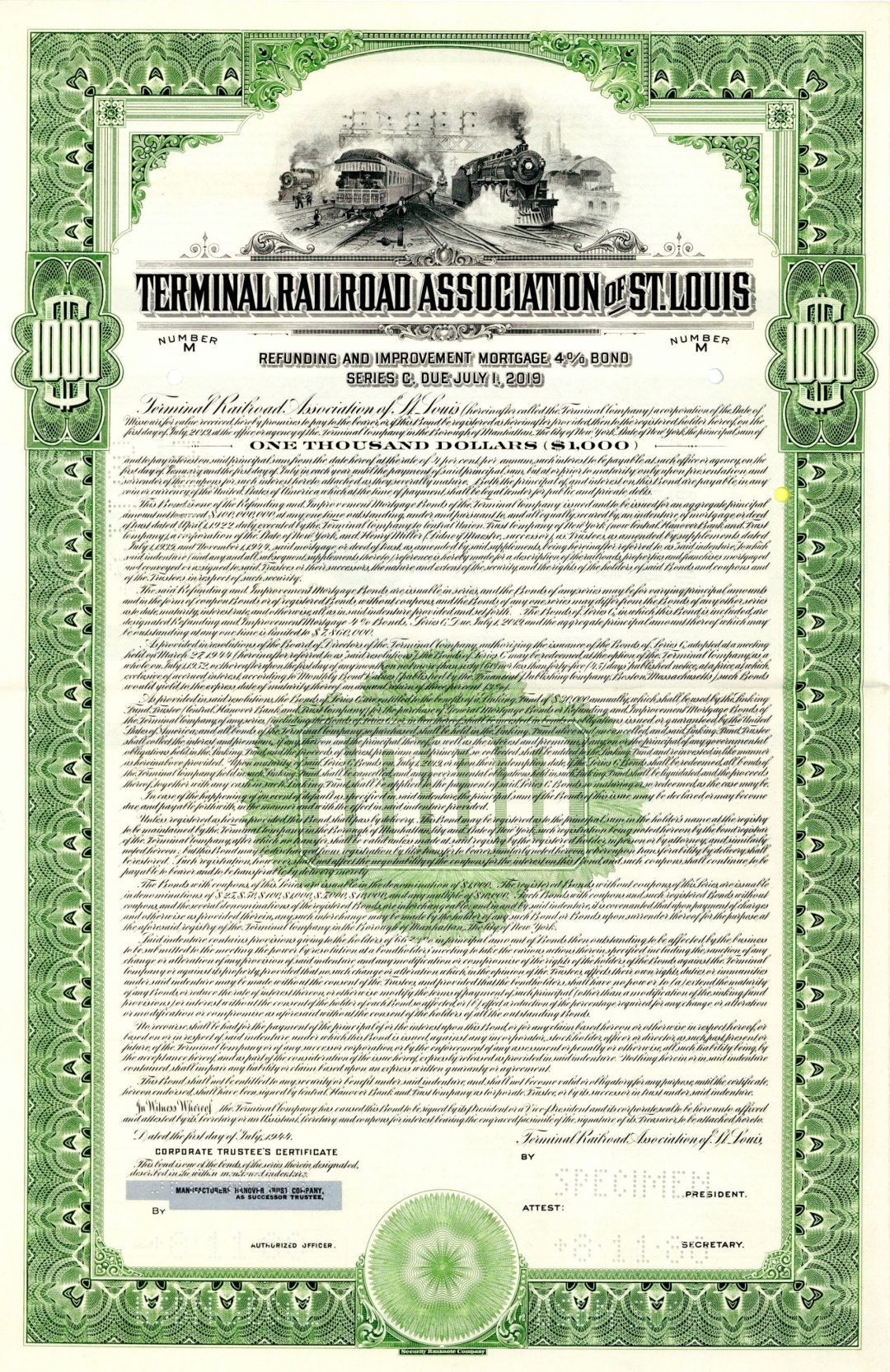Terminal Railroad Association of St. Louis - Specimen $1,000 Bond
Inv# SE3621 Specimen Bond$1,000 4% Specimen Bond printed by Security Banknote Company. Several rows of coupons at left.
The Terminal Railroad Association of St. Louis (reporting mark TRRA) is a switching and terminal railroad that handles traffic in the St. Louis, Missouri, metropolitan area. It is co-owned by several Class I railroads that reach the city.
It was founded in 1889 in a deal orchestrated by Jay Gould with:
- Missouri Pacific Railroad
- St. Louis, Iron Mountain and Southern Railway, later part of the Missouri Pacific
- Wabash Railroad, later part of the Norfolk and Western Railway
- Ohio and Mississippi Railroad, later part of the Baltimore and Ohio Railroad
- Louisville and Nashville Railroad
- Cleveland, Cincinnati, Chicago and St. Louis Railway, later part of the New York Central Railroad
Its current owners are:
- BNSF Railway (1/7)
- Canadian National Railway (1/7) (Illinois Central Railroad until 1999)
- CSX Transportation (1/7)
- Norfolk Southern Railway (1/7)
- Union Pacific Railroad (3/7)
It also connects with the Kansas City Southern Railway; the Canadian Pacific Railway is the only Class I railroad that does not reach St. Louis.
The railroad's predecessor companies in St. Louis date to 1797, when the town was still part of Spanish Upper Louisiana. James Piggott was granted a license to operate a ferry between St. Louis and Illinoistown (now East St. Louis, Illinois). In 1819, Piggott's heirs sold the ferry to Samuel Wiggins, who operated the service with eight horses until a steam-powered ferry took over in 1828.
In 1832, Wiggins sold the Wiggins Ferry Service and 800 acres (3.2Â km2) of land in East St. Louis, including Bloody Island, to new owners, who began developing a rail yard on the Illinois property. In 1870, the ferry began porting rail cars across the river one car at a time until the 1874 completion of the Eads Bridge.
When the Terminal Railroad was incorporated in 1889, railroads owned most of the Wiggins Ferry property. In 1902 when the Rock Island Line joined the Terminal Railroad, the ownership of the Wiggins Illinois property was complete.
The Association built Union Station. It owns the Merchants Bridge and MacArthur Bridge, the latter which it received in 1989 in a swap with the City of St. Louis in exchange of title for the Eads Bridge.
In the early years the Association was at odds with the St. Louis Merchants Exchange. The Exchange built the Eads Bridge but lost control to the Terminal Railroad. The Exchange then built the Merchants Bridge to keep the Terminal Railroad from having a monopoly. The Exchange then lost control of that bridge also to the Terminal Railroad.
The railroad's practice of charging a tariff to coal trains crossing the Mississippi River would persuade several industries to set up shop in Illinois rather than Missouri. The steelmaking town of Granite City, Illinois, was founded to avoid the tariffs.
For four years beginning in 2001, TRRA received the Gold E. H. Harriman Award for safety in the Switching and Terminal railroad class.
The TRRA operates the following lines:
- Merchants Subdivision: Grand Avenue (BNSF/UP) via Union Station, Gratiot Street (UP), Poplar Street (UP), North Market Street (BNSF/NS), West Approach, Merchants Bridge, and "SH" to "WR" (KCS/NS/UP/Port Harbor Railroad)
- Illinois Transfer Subdivision: "SH" via "CP" (NS), Willows (CSX/KCS), and Southern (NS) to Valley Junction (KCS/UP)
- MacArthur Bridge Subdivision: Gratiot Street (UP) via South Approach Junction (UP), MacArthur Bridge, North Approach Junction, and East Approach (Alton and Southern Railway) to Valley Junction (KCS/UP)
- North Belt Subdivision: West Approach via May Street (NS) and Carrie Avenue to Baden Yard (BNSF)
- West Belt Subdivision (Operation currently leased to West Belt Railway): Carrie Avenue to Rock Island Junction (Central Midland Railway)
- Eads Subdivision: North Approach Junction via "Q" (CSX/KCS/UP) to "CP"
Stock and Bond Specimens are made and usually retained by a printer as a record of the contract with a client, generally with manuscript contract notes such as the quantity printed. Specimens are sometimes produced for use by the printing company's sales team as examples of the firms products. These are usually marked "Specimen" and have no serial numbers.










Ebay ID: labarre_galleries